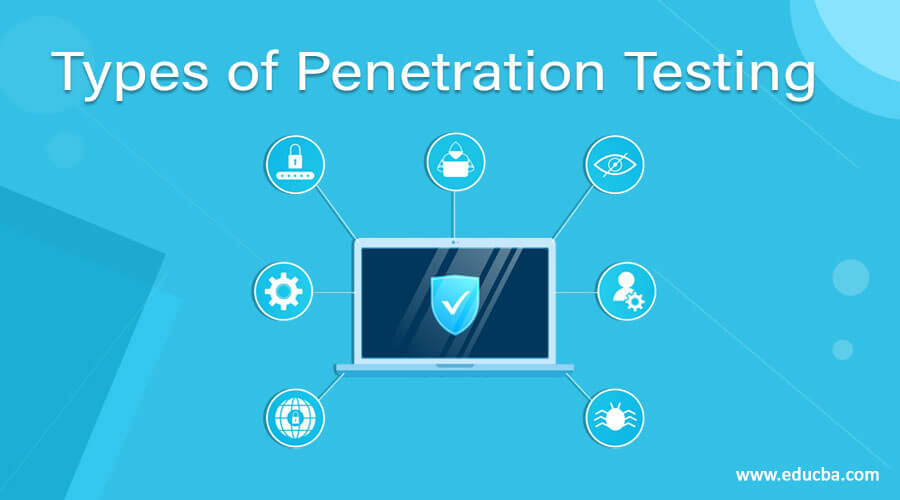Updated April 19, 2023

Types of Penetration Testing
In today’s cyber world hackers around the world attempt to penetrate network defenses with security vulnerabilities that are easily found and exploited, not only in national banks, corporate brands, government agencies but also in many organizations. By discovering and exploiting vulnerabilities, Penetration Test examines any vulnerabilities in a company’s IT infrastructure in a safe way. In the software itself, these vulnerabilities can be found at these particular points of entry:
- In the Operating System’s backdoors;
- Improper implementation of software configuration management;
- Unintentional mistakes in the code design;
Penetration Testing can be carried out by manual or automatic processes at the following endpoints:
- Servers
- Wireless networks
- Network endpoints
- Network security devices like Network Intrusion devices, Firewalls, Routers, etc.
- Mobile devices
There are various types of penetration tests, each with a different point of view and aim, so understanding the differences is important so it will be efficient to decide which type of test fits requirements and goals. Here are the most common types of penetration tests which are given as follows
1. Network Penetration Testing
Typically, network testing is the most common penetration testing process. The Pentester conducts a series of network assessments after the penetration tester performs information gathering and vulnerability assessments. internal and external network exploitation tests can be conducted to explore several aspects of an organization’s security.
Network testing includes:
- Open port scanning and testing
- Network vulnerabilities
- Router testing
- DNS footprinting
- Bypassing Firewalls
- Proxy Servers
- SSH attacks
- IDS/IPS evasion
- SQL Server;
- Simple Mail Transfer Protocol (SMTP)
- File Transfer Protocol (FTP)
2. Application penetration testing
In Web-based applications, security vulnerabilities are detected. All components are tested, like Silverlight, ActiveX, and Java applets, as well as APIs. This test more time as it is difficult compared to a network test So it is important the Web application correctly and thoroughly.
Applications for exploit consists of:
Languages in Web Applications like Java, .NET, PHP, as well as APIs, Connections such as Oracle, XML, MySQL, various Frameworks, Systems like SAP, Financial systems, CRM systems, Logistics, HR systems, and Mobile applications.
3. Wireless Network Penetration Testing
It consists of testing all the wireless devices that are used in a company such as laptops, smartphones, etc. Finding any security loopholes is also checked as follows:
- Wireless protocols (to evaluate which ones are considered in nature to be “weak”);
- Wireless Access Points (to determine the “rogue” ones);
- Administrative credentials.
A wireless test is performed at the client site in most situations since the pen testing equipment must be relatively similar to the wireless network signals.
Vulnerabilities exploited while wireless network penetration testing is as follows:
- MAC address spoofing
- Wireless encryption protocols
- Unauthorized access points and hotspots
- (XSS) Cross-site scripting
- weak or default passwords
- Denial of Service (DoS) attacks
- Wireless network traffic
- SQL injections
- Web server misconfiguration
- Web server or website for sensitive data of users
- Web servers using malware to access network in depth
4. Physical penetration testing
It may not be considered a weakness, but the physical security controls may be an entryway for attackers.
The penetration tester will attempt to gain access to the system during this physical penetration test by:
- RFID & Door Security Systems
- Lock-picking
- Personnel or impersonation of vendors
- Motion sensors
For some form of social engineering, a physical penetration test is performed. In order to gain physical access to the facility, a penetration tester may need to deceive or manipulate the staff. This leads us to a penetration test of our next form.
5. Social Engineering Testing
People make errors and can be tricked readily. Often, the weakest connection is the employees. Social engineering is a common way in which threatening actors can penetrate your environment.
types of social engineering methods used by attackers are:
- Phishing attacks
- Imposters like external vendors, fellow employees, or contractors
- Name-dropping
- Tailgating
- Pre-texting
- Eavesdropping
- Dumpster Diving
6. Cloud penetration testing
For computing, networking, and storage, public cloud services have become more and more popular. Backups and other forms of data can be stored in the cloud by businesses and employees. For hackers, this makes it a prime target. However, challenges in managing cloud protection as well as legal hurdles emerge with the ease of cloud deployments.
Testing for cloud services consists of:
- Weakly used passwords
- API and Applications access
- Database and storage access
- Encryption
- Virtual Machines and unpatched OS
- SSH and RDP remote administration
- Poorly used firewalls
Conclusion
In this article, we have seen various pen test types. Performing these various penetration test types will help the user identify the vulnerabilities which need to be patched in system security. Performing regular penetration tests is essential as a whole security strategy. So you can choose any of the given tests to perform on the system and strengthen the security.
Recommended Articles
This is a guide to Types of Penetration Testing. Here we discuss the introduction, most common types of penetration tests respectively. You may also have a look at the following articles to learn more –
